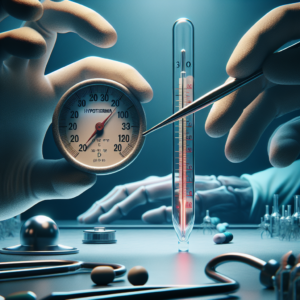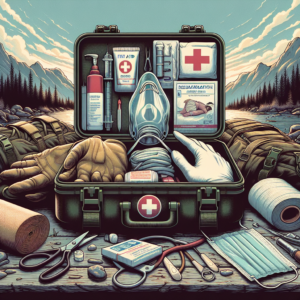
In today’s uncertain world, it is crucial to be prepared for any medical emergency that may arise. Whether you are at home, in the workplace, or traveling, having a comprehensive medical emergency kit at hand can mean the difference between life and death. This article explores the essential items that should be included in such a kit, guiding you on how to assemble a well-stocked and effective medical emergency kit that can provide immediate and vital care in life-threatening situations.
Essential Medications
Having essential medications in your medical emergency kit is crucial. Prescription medications should be included, ensuring you have an adequate supply for your specific health needs. It is important to consult with your healthcare provider to determine which medications should be included and the appropriate dosage. Over-the-counter medications such as pain relievers, fever reducers, and antihistamines should also be included in your kit. These medications can provide immediate relief for common ailments and symptoms during an emergency.
Basic Medical Supplies
In addition to medications, it is essential to have basic medical supplies in your emergency kit. Bandages are necessary for covering and protecting wounds. Having a variety of sizes and types, including adhesive and non-adhesive, ensures that you can address different kinds of injuries. Gauze pads are useful for cleaning wounds, applying ointments, and absorbing blood or other bodily fluids. Adhesive tape is necessary for securing bandages and gauze pads in place, providing stability and protection.
Wound Care
When faced with an emergency, proper wound care is crucial to prevent infection and promote healing. Including an antiseptic solution in your medical emergency kit allows you to clean wounds thoroughly. This solution helps kill bacteria and reduce the risk of infection. Antibiotic ointment, such as Bacitracin or Neosporin, should also be included to apply to wounds after cleaning. Hydrogen peroxide can be used to further cleanse and disinfect wounds, helping to remove any debris or dirt that may be present.
Tools and Instruments
Having essential tools and instruments in your medical emergency kit is important for addressing a variety of situations. Scissors are versatile tools that can be used to cut clothing, tape, or bandages in case of emergencies. Tweezers are useful for removing splinters, ticks, or other foreign objects that may become embedded in the skin. Including a thermometer enables you to monitor body temperature, which can be a vital indicator of health during emergencies.
Diagnostic Equipment
In certain emergencies, it may be crucial to have diagnostic equipment to assess someone’s condition. A blood pressure monitor allows you to measure blood pressure levels, providing valuable information for determining the severity of a situation. A stethoscope enables you to listen to heart and lung sounds, helping you assess the respiratory and circulatory systems. A glucometer is essential for measuring blood glucose levels, particularly important for individuals with diabetes or during medical emergencies related to blood sugar levels.
Personal Protective Equipment
Ensuring your safety and the safety of others is paramount during emergencies. Disposable gloves should be included in your medical emergency kit to protect against contact with bodily fluids or other potentially harmful substances. Face masks provide a barrier against respiratory droplets, particularly useful during viral outbreaks or when encountering situations that may involve airborne particles. Eye protection, such as safety goggles or glasses, prevents eye contact with hazardous materials or potential debris.
Emergency Contact Information
Having access to emergency contact information is crucial during an emergency. Include a list of relevant emergency phone numbers, such as local emergency services, poison control, or healthcare providers. It is also important to include a medical information sheet that includes your personal medical history, allergies, medications, and any other relevant information. This allows emergency responders or healthcare professionals to have quick access to your medical information, aiding in swift and appropriate medical assistance.
Documentation
Including documentation in your medical emergency kit ensures you have the necessary resources to respond confidently during emergencies. A first aid manual provides step-by-step instructions on how to administer basic first aid procedures. It serves as a comprehensive guide and a valuable reference when faced with unfamiliar situations. A first aid logbook allows you to record details of any treatments or interventions performed during emergencies. This logbook can be useful for tracking progress, sharing information with healthcare providers, or for legal or insurance purposes.
Comfort Items
During medical emergencies, providing comfort is not only essential for physical well-being but also for mental and emotional support. Including a blanket in your emergency kit allows you to provide warmth and comfort, particularly in situations where individuals may be exposed to cold temperatures or shock. A heat pack can be utilized to relieve pain or provide warmth for individuals who may be experiencing discomfort. Earplugs help to block out excessive noise, creating a more peaceful environment during emergencies.
Additional Supplies
In addition to the above-mentioned items, there are a few additional supplies that can further enhance the effectiveness of your medical emergency kit. An emergency blanket, also known as a space blanket, provides insulation and protection from extreme temperatures. This lightweight and compact blanket can make a significant difference in preventing hypothermia and maintaining body heat. A whistle is a useful tool for attracting attention during emergencies, ensuring others can locate and assist you. Finally, having emergency food and water in your kit allows you to sustain yourself and others until help arrives or the situation is resolved.
In conclusion, a comprehensive medical emergency kit should include essential medications, basic medical supplies, wound care products, tools, diagnostic equipment, personal protective equipment, emergency contact information, documentation, comfort items, and additional supplies. Being prepared with these items can make a significant difference in providing immediate assistance during emergencies and increasing the chances of a positive outcome. Adapt and customize your kit based on your specific needs and ensure regular maintenance and replenishment of supplies to be fully prepared for any unforeseen circumstances.







